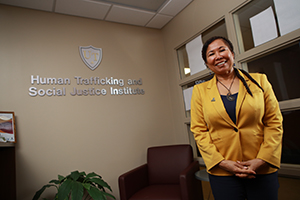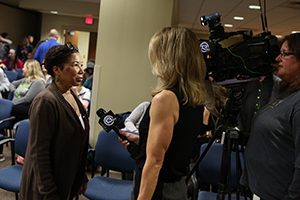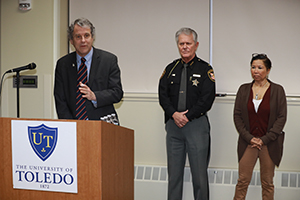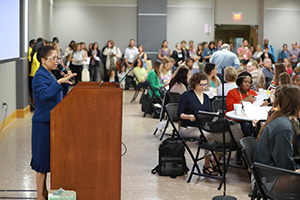Freeing the enslaved
Expert on human trafficking seeks solutions to ‘human rights issue of our lifetime’
By Laurie B. Davis

“I began thinking about my supposed Christian principles. As social workers, our primary mission is to work with the poor, the vulnerable and the oppressed. That’s our ethical mission,” says Williamson, professor of social work and director of UT’s Human Trafficking and Social Justice Institute. “I had a change of heart, and then I started to build a relationship with women on the streets.”
For six months, Williamson spent time doing outreach and building relationships with these women to earn their trust. “I was out there three times a week, all day, learning the culture of trafficking, learning who the pimps were, where the dope houses were, the language and all of that,” says Williamson. She created a social work organization based on the needs of the women she befriended, and together they named it Second Chance.
Since the 1990s, human trafficking has morphed into a billion-dollar business with estimates of more than 40 million people across the world being trafficked for sex or labor. Today, Williamson believes human trafficking is the human rights issue of our lifetime, and the research she’s done and efforts she’s made over the past 25 years have been focused on ending it.
Coordinating a response
Research, evidence-based interventions and prevention are at the heart of the Institute’s work. Williamson and her team helped establish the Lucas County Human Trafficking Coalition, which comprises members from health care, social service, law enforcement, government agencies, churches, and some individuals who have worked in the sex industry. Together, they strategize and implement tactics to help victims and to protect youths from recruitment.
UT’s Institute also is a founding member of the state’s Anti-Trafficking Commission under the Ohio Attorney General. Williamson and her team of researchers are responsible for publishing numerous studies on human trafficking and obtaining federal grants for funding, including those it has received from the National Institutes of Health and the Department of Justice. “UT has had a significant impact on what’s happening in Ohio, as far as anti-trafficking efforts,” says Williamson.
Williamson’s advocacy spreads across the world. She has given more than 200 presentations and more than 20 keynote addresses at conferences to share information about the efforts and outcomes of the work of the Institute at UT. Traveling to Washington, D.C. to inform the FBI about Toledo’s human trafficking program, she learned that victims from Toledo had been found in various locations during federal investigations. In 2006, an FBI taskforce came to Toledo, which remains a hub for human trafficking. Williamson says more than 200 youths have been rescued by the FBI/Northwest Ohio collaboration, which is called the Northwest Ohio Violent Crimes Against Children Task Force.
To inform other communities across the world and to share research findings, Williamson created what is now considered the oldest and largest global conference. Begun in 2003, the conference draws attendees from 42 states and 30 countries. She also developed the Global Association of Human Trafficking Scholars, and serves as an editorial manager for the Journal of Human Trafficking for publishing research.
A PATH to healing
One of the Institute’s major initiatives is a comprehensive victim assistance model called Partners Against Trafficking Humans, or PATH, which operates as a network of more than 60 agencies. Their coordinated efforts help victims escape trafficking and provide the services victims need to heal their physical, psychological and emotional wounds. The intent is to move victims beyond surviving to a point of thriving.

“First of all, it illuminates the process, so you can see what’s working and what’s not working. Then, we can go from there. We can say ‘let’s do more of this, this seems to be working,’ and ‘let’s do less of that.’ That’s where we are right now,” says Williamson.
Evaluations also can reveal issues to address. Williamson says PATH has encouraged clients to focus more on clinic visits for chronic conditions rather than visiting emergency rooms for acute health issues that pop up. While this has saved a lot of money, she says, practitioners also discovered that about 40 percent of the women have suffered a significant head or neck injury, indicating the possibility of a traumatic brain injury. If such an injury exists, then interventions — like talk therapy for example — may be ineffective. “If you have a traumatic brain injury, how effective can this type of counseling be if you can’t process the information? So, that’s been a profound discovery,” says Williamson. “We’ve been over to UTMC, trying to build a streamlined process for victims to go in and get an assessment from a neurologist,” she says.
Sex trafficking in the age of the Internet
Preventing human traffickers from successfully luring teenagers into dangerous situations, from which they may not escape, is one of the goals of an anti-trafficking curriculum for youths within the juvenile court systems, the Department of Youth Services, Child Protection, after-school programs in low-income communities, and it is used in high schools.
“Our curriculum is focused on those kids most likely to be trafficked,” says Williamson. “Those are the kids who need concentrated, focused efforts to help move them from vulnerability,” she says. Children living within families that are caring and communicative are at low risk of being trafficked, says Williamson. “But that kid who is really vulnerable, because they’ve been abused as a younger child, or they live in poverty, or they are from the LGBTQ community, or they ran away from home: those kids are at high-risk. If we have limited resources and energy, we should be spending every moment of our time getting to those kids at high-risk,” she says.
The most vulnerable kids are runaways. If these kids connect with a stranger online, they may get caught in a trafficker’s web. A 2018 study conducted by the Institute links social media and sex trafficking. Human traffickers, the study reports, seek out vulnerable youths on social media platforms. They look for comments that express fear, emptiness, disappointment and loneliness, as well as indicators of runaway activity, substance abuse or a dysfunctional home life. These factors make it easier for a trafficker to earn a teen’s trust through manipulating their online interaction.
Accountability
As part of the fight against human trafficking, Williamson and the Lucas County Human Trafficking Coalition worked with U.S. Sen. Sherrod Brown to push a federal law that adds time to prison sentences for traffickers who use drugs to coerce victims. They also worked alongside UT alumna and Ohio state Sen. Teresa Fedor (D-Toledo) on passing laws that protect victims and punish traffickers and customers. With support from the coalition, Fedor (Ed’83) led legislation that passed into laws in Ohio in 2010, 2012 and 2014. The End Demand Act, which focused on stricter felony penalties for customers who purchase sex from minors, became law in 2014.

causing their victims to become drug-addicted or exacerbating an existing addiction. It would also help protect victims who have been forced by traffickers to commit crimes. Celia Williamson (right), professor of social work and director of UT’s Human Trafficking and Social Justice Institute, also attended the news conference.
Even with the barriers that victim advocates face, Williamson says public awareness of human trafficking is on the rise. A core American principle may be why more voices of outrage are growing across the country, including those of celebrities. “People become passionate about the issue because of its connection to the fundamental idea of freedom,” says Williamson.
“The U.S. government talks about this issue as being modern-day slavery. That’s exactly what it is when somebody’s freedom is taken and somebody is making money off of it,” says Williamson.
“Americans have a painful history with slavery; we don’t throw that word around lightly unless that’s exactly what’s happening. We have a deeply held principle of freedom. That’s why I say it’s the human rights issue of our lifetime, because we’re fighting something that’s very fundamental to who we are in the United States and in the universal declaration of human rights.”
If you would like to join the fight against human trafficking, you can support the Human Trafficking Progress Fund (2402218) by clicking here.








